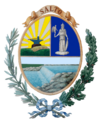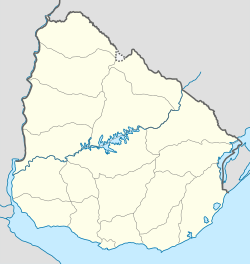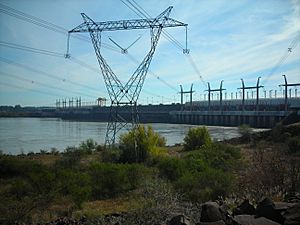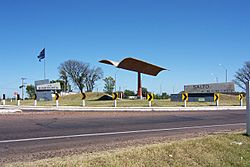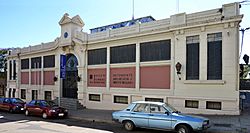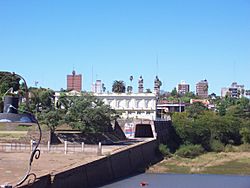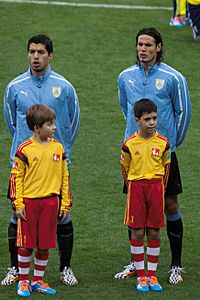Salto, Uruguay facts for kids
Quick facts for kids
Salto
|
||
|---|---|---|
|
Department capital city
|
||

Monument to José Gervasio Artigas, by Edmundo Prati, at Plaza Artigas in downtown Salto.
|
||
|
||
| Motto(s):
"En el Trabajo está su Porvenir, y en la Sabiduría y Prudencia, su destino" ("Its future is in the Labour, and its destiny in Wisdom and Prudence")
|
||
| Country | ||
| Department | ||
| Founded | 1756 | |
| Population
(2011 Census)
|
||
| • Total | 104,028 | |
| • Demonym | salteño | |
| Time zone | UTC −3 | |
| Postal code |
50000
|
|
| Dial plan | +598 473 (+5 digits) | |
| Climate | Cfa | |
Salto is a big city in northwestern Uruguay. It is the capital city of the Salto Department. In 2011, over 104,000 people lived there. This makes Salto the second largest city in Uruguay, right after Montevideo.
Contents
History of Salto: From Fort to City
Salto has a long and interesting history. It started as a small camp and grew into a bustling city.
Early Days: A Military Camp (1756-1768)
The first settlement in Salto began in 1756. This happened during the Guarani War. A governor named José Joaquín de Viana built barracks for his soldiers. They called this camp San Antonio del Salto Chico. The soldiers lived by hunting and fishing.
In 1757, a strong fort was built here. It was also named San Antonio and had a small chapel. Spanish troops used this area for several years.
Changing Hands and Jesuit Expulsion (1768)
In 1768, new troops arrived in Salto. They were led by Francisco de Paula Bucareli. Their mission was to remove the Jesuits from Spanish lands. The fort became a place to store weapons. It also served as a prison for many priests.
Later, a big flood damaged the fort. It was rebuilt on the other side of the Uruguay River. This new location was near where the city of Concordia is today. By 1782, people started living there permanently.
The Fight for Independence: Artigas's Role
A very important event in Uruguay's history happened near Salto. In 1811, a war began against the Spanish. A famous leader named José Gervasio Artigas led the fight. He was known as the "Chief of the Orientales."
Artigas and his followers camped near Salto in December 1811. This was part of a big journey called the "Exodus of the Western People." Many people, including soldiers and families, moved north with him. Artigas guided the people in their fight for freedom. His efforts helped lead to Uruguay becoming an independent country in 1825.
Salto Grows: From Village to City
Before Uruguay became independent, Salto was a small village.
- In 1835, it was officially recognized as a "Villa" (town).
- In 1837, Salto became the capital of its department.
- In 1863, Salto was officially made a "Ciudad" (city). This status was confirmed again in 1869.
Garibaldi's Battle in Salto (1845-1846)
In 1845, a famous Italian general named Giuseppe Garibaldi came to Salto. He led troops who fought against local forces. In February 1846, Garibaldi won a battle near Salto. This victory made him well-known in the region.
Population Growth in Salto
Salto has grown a lot over the years. Here's how its population has changed:
| Year | Population |
|---|---|
| 1834 | 1,315 |
| 1852 | 2,882 |
| 1908 | 19,788 |
| 1963 | 57,975 |
| 1975 | 73,897 |
| 1985 | 80,821 |
| 1996 | 93,117 |
| 2004 | 99,072 |
| 2011 | 104,028 |
Source: Instituto Nacional de Estadística de Uruguay
Geography and Climate of Salto
Salto is located in a special place in Uruguay. It sits on the eastern bank of the Río Uruguay.
Location and Surroundings
The city is about 496 kilometers (308 miles) northwest of Montevideo, Uruguay's capital. Right across the river is the city of Concordia in Argentina.
About 12 kilometers (7.5 miles) north of Salto, you'll find the Salto Grande Dam. A bridge on top of this dam connects Uruguay and Argentina. Salto is built on hills and bluffs. It is near the "big jump" falls of the Uruguay River. The city's elevation is about 48 meters (157 feet) above sea level.
Salto's Climate: Warm and Sunny
Salto has a humid subtropical climate. This means it has sunny and hot summers. Sometimes there is heavy rainfall. The winters are usually mild.
| Climate data for Salto (1991–2020, extremes 1942–2020) | |||||||||||||
|---|---|---|---|---|---|---|---|---|---|---|---|---|---|
| Month | Jan | Feb | Mar | Apr | May | Jun | Jul | Aug | Sep | Oct | Nov | Dec | Year |
| Record high °C (°F) | 42.2 (108.0) |
41.6 (106.9) |
40.0 (104.0) |
37.0 (98.6) |
32.4 (90.3) |
30.8 (87.4) |
31.6 (88.9) |
35.5 (95.9) |
38.4 (101.1) |
37.8 (100.0) |
39.5 (103.1) |
41.0 (105.8) |
42.2 (108.0) |
| Mean daily maximum °C (°F) | 32.2 (90.0) |
30.7 (87.3) |
29.0 (84.2) |
25.2 (77.4) |
21.1 (70.0) |
18.5 (65.3) |
18.1 (64.6) |
20.8 (69.4) |
22.4 (72.3) |
25.1 (77.2) |
28.3 (82.9) |
30.7 (87.3) |
25.2 (77.4) |
| Daily mean °C (°F) | 25.6 (78.1) |
24.6 (76.3) |
22.7 (72.9) |
19.2 (66.6) |
15.7 (60.3) |
13.2 (55.8) |
12.6 (54.7) |
14.5 (58.1) |
16.1 (61.0) |
19.0 (66.2) |
21.7 (71.1) |
24.0 (75.2) |
19.1 (66.4) |
| Mean daily minimum °C (°F) | 19.1 (66.4) |
18.4 (65.1) |
16.5 (61.7) |
13.4 (56.1) |
10.3 (50.5) |
8.0 (46.4) |
7.1 (44.8) |
8.2 (46.8) |
9.9 (49.8) |
12.9 (55.2) |
15.0 (59.0) |
17.3 (63.1) |
13.0 (55.4) |
| Record low °C (°F) | 8.3 (46.9) |
7.0 (44.6) |
4.4 (39.9) |
0.4 (32.7) |
−2.0 (28.4) |
−5.6 (21.9) |
−5.0 (23.0) |
−3.6 (25.5) |
−3.0 (26.6) |
−0.8 (30.6) |
3.6 (38.5) |
5.4 (41.7) |
−5.6 (21.9) |
| Average precipitation mm (inches) | 129.6 (5.10) |
142.1 (5.59) |
128.4 (5.06) |
157.2 (6.19) |
105.2 (4.14) |
79.9 (3.15) |
55.1 (2.17) |
69.4 (2.73) |
86.3 (3.40) |
149.5 (5.89) |
130.5 (5.14) |
152.6 (6.01) |
1,385.8 (54.56) |
| Average precipitation days (≥ 1.0 mm) | 7 | 7 | 7 | 7 | 6 | 5 | 5 | 5 | 6 | 8 | 7 | 7 | 77 |
| Average relative humidity (%) | 62 | 67 | 70 | 75 | 78 | 80 | 76 | 72 | 69 | 69 | 65 | 62 | 71 |
| Mean monthly sunshine hours | 283.1 | 238.7 | 242.5 | 193.2 | 168.1 | 140.7 | 164.5 | 195.6 | 201.0 | 222.6 | 260.0 | 281.8 | 2,591.8 |
| Source 1: Instituto Uruguayo de Metereología | |||||||||||||
| Source 2: NOAA (precipitation and sun 1991–2020), Instituto Nacional de Investigación Agropecuaria (humidity 1980–2009) | |||||||||||||
Architecture and Landmarks
Salto has many interesting buildings and places to see.
Famous Buildings and Designs
At the entrance of the city, you can see a memorial to engineer Eladio Dieste. It's called "La Puerta de la Sabiduría" (The Door of Wisdom). People often call it "La Gaviota" (The Seagull). Dieste designed many buildings in Salto. These include an industrial warehouse and a bus terminal.
City Center and Important Places
The main street in Salto is Calle Uruguay. This is where many businesses are located. Many old buildings in this area are very important. "El Mirador" is the tallest building in the city. It opened in 2007.
A notable place to visit is the Museo del Hombre y la Tecnología. This museum teaches about people and technology. In the center of the city, there is a square called Plaza Artigas. It has a large statue of General Artigas. The biggest park in Salto is Parque Solari.
Places of Worship
Salto has several churches:
- Cathedral Basilica of St. John the Baptist (Roman Catholic)
- Holy Cross Parish Church (Roman Catholic)
- Sacred Heart of Jesus Parish Church (Roman Catholic)
- Parish Church of Our Lady of Mt. Carmel (Roman Catholic)
Culture and Fun in Salto
Salto offers many attractions and activities.
Thermal Pools and Social Life
One of the most popular attractions is the thermal pools. These pools are heated by natural springs. Their water stays warm, over 38 °C (100 F), all year round.
Calle Uruguay is a famous street in Salto. On weekend nights, locals enjoy walking along this street. They socialize and drink mate with friends.
Sports in Salto
Football is a popular sport here. The main football club is Salto Fútbol Club. They play at the Estadio Ernesto Dickinson, which can hold about 6,500 people. Salto was also one of the cities that hosted the 1967 Basketball World Cup.
Transportation in Salto
Getting to and around Salto is easy.
Roads, Rails, and Air Travel
Salto is located where two important roads meet: National Route 3 (north-south) and National Route 31 (east-west). It's about 145 kilometers (90 miles) south of Bella Union. It is also about 120 kilometers (75 miles) north of Paysandu.
You can travel to Montevideo by bus or train. The main train station is Salto railway station (Estacion Salto). Salto also has an airport called Nueva Hesperides International Airport. This airport used to have flights to Montevideo. There are plans to improve it for future travel and to help local businesses ship goods.
Notable People from Salto
Many famous people were born in Salto:
- Horacio Quiroga (born 1879): A well-known Uruguayan author.
- Enrique Amorim (born 1900): Another important Uruguayan author.
- Pedro Rocha (born 1942): A famous football player for Peñarol.
- Luis Suárez (born 1987): A world-famous football player who plays for Inter Miami CF.
- Edinson Cavani (born 1987): Another world-famous football player who plays for Boca Juniors.
- Bruno Fornaroli (born 1987): A professional football player for Melbourne Victory.
- Pablo Cuevas: A top Uruguayan tennis player who lives in Salto.
See also
 In Spanish: Salto (Uruguay) para niños
In Spanish: Salto (Uruguay) para niños


